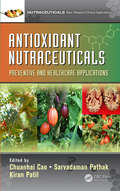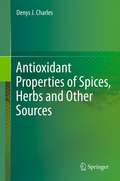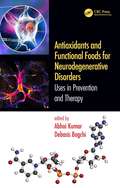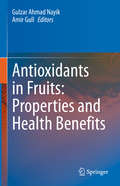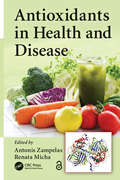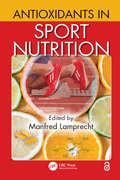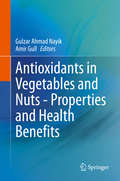- Table View
- List View
Antineoplastic and Immunosuppressive Agents: Part II (Handbook of Experimental Pharmacology #38 / 2)
by Alan C. Sartorelli David G. JohnsOver the past two decades a number of attempts have been made, with varying degrees of success, to collect in a single treatise available information on the basic and applied pharmacology and biochemical mechanism of action of antineoplastic and immunosuppressive agents. The logarithmic growth of knowledge in this field has made it progressively more difficult to do justice to all aspects of this topic, and it is possible that the present handbook, more than four years in preparation, may be the last attempt to survey in a single volume the entire field of drugs employed in cancer chemotherapy and immunosuppression. Even in the present instance, it has proved necessary for practical reasons to publish the material in two parts, although the plan of the work constitutes, at least in the editors' view, a single integrated treatment of this research area. A number of factors have contributed to the continuous expansion of research in the areas of cancer chemotherapy and immunosuppression. Active compounds have been emerging at ever-increasing rates from experimental tumor screening systems maintained by a variety of private and governmental laboratories through out the world. At the molecular level, knowledge of the modes of action of established agents has continued to expand, and has permitted rational drug design to play a significantly greater role in a process which, in its early years, depended almost completely upon empirical and fortuitous observations.
Antiosteoporotika: Strategien, Indikationen, Wirkungen, Nebenwirkungen, Monitoring (essentials)
by Reiner BartlOsteoporose ist keine einfach hinzunehmende „Alterserscheinung“, sondern ein weltweites und zunehmendes Gesundheitsproblem. Die WHO hat die Osteoporose als eine der zehn wichtigsten und teuersten Volkskrankheiten eingestuft. In Europa sind jede dritte Frau und jeder fünfte Mann davon betroffen, mit den Folgen langanhaltender Schmerzen, körperlicher Beeinträchtigung bis hin zur Immobilität, sozialer Isolierung und Pflegebedürftigkeit. Heute ist aber der Knochenschwund in Form der Osteoporose als eine frühdiagnostizierbare, gut behandelbare und im Frühstadium sogar „heilbare“ Krankheit einzustufen. Der praktische und konsequente Einsatz der zahlreichen und unterschiedlich wirksamen Medikamente ist jetzt Aufgabe der behandelnden Ärzte und betroffenen Patienten– eine multidisziplinäre Anstrengung, die sich lohnt!…Osteoporose ist heute so überflüssig wie ein Kropf!
Antioxidant Nutraceuticals: Preventive and Healthcare Applications (Nutraceuticals)
by Chuanhai Cao Sarvadaman Pathak Kiran PatilThis book addresses various clinical and sub clinical applications of antioxidant nutraceuticals, with a primary focus on preventive use for general wellness, common ailments, and such chronic illnesses as cancer and neurological applications. This unique book captures the applications of natural antioxidants, which have been used for thousands of years in Traditional Chinese Medicine and Ayurvedic Medicine as well as modern nutraceuticals formulations. It covers antioxidant applications in clinical scenarios including the historical perspective, basic antioxidant properties and applications, anti-inflammatory properties, and antioxidant applications in a variety of clinical conditions.
Antioxidant Nutraceuticals: Preventive and Healthcare Applications (Nutraceuticals)
by Chuanhai Cao Sarvadaman Pathak Kiran PatilThis book addresses various clinical and sub clinical applications of antioxidant nutraceuticals, with a primary focus on preventive use for general wellness, common ailments, and such chronic illnesses as cancer and neurological applications. This unique book captures the applications of natural antioxidants, which have been used for thousands of years in Traditional Chinese Medicine and Ayurvedic Medicine as well as modern nutraceuticals formulations. It covers antioxidant applications in clinical scenarios including the historical perspective, basic antioxidant properties and applications, anti-inflammatory properties, and antioxidant applications in a variety of clinical conditions.
Antioxidant Properties of Spices, Herbs and Other Sources
by Denys J. CharlesThe scientific world and modern society today is experiencing the dawning of an era of herbal medicine. Extensive research has shown that aromatic plants are important anti-inflammatory, antioxidant, anti aging and immune boosting delectable foods, with the magic and miracle to boost our immune system providing us with extended and an improved quality of life. Apart from making bland recipes into welcoming or interesting victories, herbs and spices have stirred the minds of the research community to look deeper into its active components from a functional perspective. It is essential to present the scientific and medicinal aspect of herbs and spices together with the analysis of constituents, its medicinal application, toxicology and its physiological effects. Herbs and spices with high levels of antioxidants are in great demand as they tend to promote health and prevent diseases naturally assuring increased safety and reliability for consumers. Herbs and spices are not only known for taste and flavor, but today research has opened up a new realm in which the antioxidant properties of these aromatic plants provide preservation for foods and health benefits for consumers who look forward to concrete scientific research to guide them further and explore herbal medicine. The aim of this book is to create awareness in society about the reliability of medicinal properties of certain herbs and spices through scientific and scholarly research.
Antioxidant Status, Diet, Nutrition, and Health (Contemporary Food Science Ser.)
by Andreas M. PapasThis is the first book to integrate the biological, nutritional, and health aspects of antioxidant status. Fifty contributors integrate and transfer the knowledge of free radicals and antioxidants from the test tube to the laboratory of the biologist, clinical nutritionist, and medical researcher, as well as to the office of the dietician, nutritionist, and physician. Topics examined include factors affecting and methods for evaluating antioxidant status in humans; effect of diet and physiological stage (infancy, aging, exercise, alcoholism, HIV infection, etc.) on antioxidant status; and the role of antioxidant status in nutrition, health, and disease.
Antioxidant Status, Diet, Nutrition, and Health (Contemporary Food Science Ser.)
by Andreas M. PapasThis is the first book to integrate the biological, nutritional, and health aspects of antioxidant status. Fifty contributors integrate and transfer the knowledge of free radicals and antioxidants from the test tube to the laboratory of the biologist, clinical nutritionist, and medical researcher, as well as to the office of the dietician, nutritionist, and physician. Topics examined include factors affecting and methods for evaluating antioxidant status in humans; effect of diet and physiological stage (infancy, aging, exercise, alcoholism, HIV infection, etc.) on antioxidant status; and the role of antioxidant status in nutrition, health, and disease.
Antioxidants and Cardiovascular Disease (Developments in Cardiovascular Medicine #258)
by Martial G. Bourassa Jean-Claude TardifChronic oxidative stress is associated with the aging process and often leads to the development of disorders such as cancer and arterial disease. Cardiovascular conditions in which oxidation damage has been strongly implicated include atherosclerosis, myocardial ischemia and reperfusion, coronary restenosis, diabetes mellitus, and congestive heart failure. Antioxidants and Cardiovascular Disease, Second Edition covers three major topics: 1) the first seven chapters review the oxidative modifcation hypothesis and its close relationship to lipid metabolism and to the pathogenesis of atherosclerosis; 2) the next four chapters describe the different compounds, nutrients and supplements with antioxidant properties and their mechanisms of action; 3) and finallly, the last ten chapters discuss the potential benefits of antioxidants in overall cardiovascular prevention, including hypertension, diabetes mellitus, dyslipidemias, and in the treatment and prevention of specific conditions such as chronic coronary artery disease, restenosis after percutaneous coronary intervention, and chronic heart failure. Antioxidants and Cardiovascular Disease, Second Edition is written by recognized experts in the fields of atherosclerosis, heart failure and antioxidants. It should be of interest to medical students and fellows, researchers, and practicing physicians. There has been rapid progress in our knowledge in this field during the last two to three years. Thus the current reedition appears timely. For instance, this second edition captures several recently reported and published clinical trials as welll as new information on diabetic and hypertensive cardiovascular disease.
Antioxidants and Cardiovascular Disease (Developments in Cardiovascular Medicine #233)
by J. C. Tardif Martial G. BourassaGeneration of oxidants or reactive oxygen species is a natural process of human biology. Mitochondrial respiration, phagocytic activity and cyclooxygenase activation are all essential processes of life, which also generate oxidative species. In humans, chronic oxidative stress often coupled with deficiency of antioxidant defenses is associated with the aging process and can lead to the development of disorders such as cancer and arterial disease. Major cardiovascular conditions in which oxidative damage has been strongly implicated include atherosclerosis, myocardial ischemia and reperfusion, coronary restenosis and congestive heart failure. Compelling evidence points to oxidative stress as an important trigger in the complex chain of events leading to atherosclerosis. The expression of chemotactic factors and adhesion molecules is modified by oxidative stress. Exposure to superoxide ions activates the NF-kappa B regulatory complex and triggers the transcription of several atherosclerosis related genes. These events lead to the accumulation of macrophages in the arterial wall. Macrophages avidly incorporate oxidized low-density lipoproteins (LDL) to form foam cells. The activity of matrix metalloproteinases is also regulated by oxidative stress. This activity appears to be closely coupled with smooth muscle cell activation and migration. Matrix metalloproteinases have also been implicated in the pathophysiology of plaque rupture. Antioxidant supplementation including vitamin E decreases susceptibility ofLDL to oxidation and retards the progression of atherosclerosis in animal models.
Antioxidants and Functional Foods for Neurodegenerative Disorders: Uses in Prevention and Therapy
by Abhai Kumar Debasis BagchiNeurodegenerative diseases, including Alzheimer’s and Parkinson’s disease, are a growing problem across the world’s aging population. Oxidative stress in the brain plays a central role in a common pathophysiology of these diseases. This book presents scientific research on the potential of antioxidant therapy in the prevention and treatment of neurodegenerative disorders.This book outlines the roles of oxidative stress and diabetes mellitus in neurodegeneration, describes the molecular mechanisms of neurodegenerative disorders including the roles of environmental pollutants and inflammatory responses, and explores mitochondrial dysfunction. It then describes the protective abilities of antioxidants – including vitamin D, tocotrienol and coenzyme Q10 – against neurodegeneration. The book demonstrates the therapeutic potential of ketogenic diets, and highlights the roles of medicinal plants, phytopharmaceuticals, traditional medicines and food nutrients in neuroprotection.Key Features: Explains damage caused by numerous neurodegenerative disorders and the possible protection offered by antioxidants and functional foods. Describes molecular mechanisms of neurodegeneration by oxidative stress, advancing age, diabetes and mitochondrial dysfunctions. Demonstrates protection offered by nutraceuticals, antioxidants, botanical extracts and functional foods. The book contains twenty-three chapters divided into six sections written by leading researchers. This book is essential reading for health professionals, dietitians, food and nutrition scientists and anyone wanting to improve their knowledge of etiology of neurodegenerative diseases.
Antioxidants and Functional Foods for Neurodegenerative Disorders: Uses in Prevention and Therapy
by Abhai Kumar Debasis BagchiNeurodegenerative diseases, including Alzheimer’s and Parkinson’s disease, are a growing problem across the world’s aging population. Oxidative stress in the brain plays a central role in a common pathophysiology of these diseases. This book presents scientific research on the potential of antioxidant therapy in the prevention and treatment of neurodegenerative disorders.This book outlines the roles of oxidative stress and diabetes mellitus in neurodegeneration, describes the molecular mechanisms of neurodegenerative disorders including the roles of environmental pollutants and inflammatory responses, and explores mitochondrial dysfunction. It then describes the protective abilities of antioxidants – including vitamin D, tocotrienol and coenzyme Q10 – against neurodegeneration. The book demonstrates the therapeutic potential of ketogenic diets, and highlights the roles of medicinal plants, phytopharmaceuticals, traditional medicines and food nutrients in neuroprotection.Key Features: Explains damage caused by numerous neurodegenerative disorders and the possible protection offered by antioxidants and functional foods. Describes molecular mechanisms of neurodegeneration by oxidative stress, advancing age, diabetes and mitochondrial dysfunctions. Demonstrates protection offered by nutraceuticals, antioxidants, botanical extracts and functional foods. The book contains twenty-three chapters divided into six sections written by leading researchers. This book is essential reading for health professionals, dietitians, food and nutrition scientists and anyone wanting to improve their knowledge of etiology of neurodegenerative diseases.
Antioxidants and the Skin: Second Edition
by Roger L. McMullenThis highly illustrated book brings together many concepts related to skin care and antioxidant usage in one convenient text. The second edition now contains the latest antioxidants being marketed, and an analysis of risks and benefits associated.
Antioxidants and the Skin: Second Edition
by Roger L. McMullenThis highly illustrated book brings together many concepts related to skin care and antioxidant usage in one convenient text. The second edition now contains the latest antioxidants being marketed, and an analysis of risks and benefits associated.
Antioxidants in Andrology (Trends in Andrology and Sexual Medicine)
by Giancarlo Balercia Loredana Gandini Andrea Lenzi Francesco LombardoThis book focuses on the use of various molecules with antioxidant properties in the treatment of major male genital tract disorders, especially male infertility, erectile dysfunction, and accessory gland infection. The coverage also includes discussion of pathophysiology, the molecular basis of male infertility, and the rationale for use of antioxidants, with particular attention to coenzyme Q10 and carnitine. Oxidative stress occurs when the production of reactive oxygen species, including free radicals, exceeds the body’s natural antioxidant defences, leading to cellular damage. Oxidative stress is present in about half of all infertile men, and reactive oxygen species can produce infertility both by damaging the sperm membrane, with consequences for sperm motility, and by altering the sperm DNA. There is consequently a clear rationale for the use of antioxidant treatments within andrology, and various in vitro and in vivo studies have indicated that many antioxidants indeed have beneficial impacts. In providing a detailed and up-to-date overview of the subject, this book will be of interest to both practitioners and researchers in andrology, endocrinology, and urology.
Antioxidants in Fruits: Properties and Health Benefits
by Gulzar Ahmad Nayik Amir GullThis book provides a comprehensive review of the antioxidant value of widely consumed fruits. Each chapter covers the botanical description, nutritional & health properties of these popular fruits. Fruits are one of the most important indicators of dietary quality and offer protective effects against several chronic diseases such as cardiovascular diseases, obesity, and various types of cancer. In order to effectively promote fruit consumption, it is necessary to know and understand the components of fruits. In addition to underscoring the importance of fruit consumption’s effects on human diet, the book addresses the characterization of the chemical compounds that are responsible for the antioxidant proprieties of various fruits.Given its scope, the book will be of interest to graduate and post-graduate students, research scholars, academics, pomologists and agricultural scientists alike. Those working in various fruit processing industries and other horticultural departments will also find the comprehensive information relevant to their work.
Antioxidants in Health and Disease
by Antonis Zampelas and Renata MichaAntioxidant use in health promotion and disease prevention either through dietary intake or supplementation is controversial. This book reviews the latest evidence-based research in the area, principally through prospective cohort studies and randomized controlled trials. It assesses major dietary antioxidants and discusses their use in diseases such as cancer, diabetes, stroke, coronary heart disease, HIV/AIDS, and neurodegenerative and immune diseases. The use of antioxidants in health is also discussed along with common adverse effects associated with antioxidant use.
Antioxidants in Health and Disease
by Antonis Zampelas Renata MichaAntioxidants in Health and Disease discusses the effects of dietary antioxidants and antioxidant supplementation in humans. It reviews the latest evidence-based research in the area, principally through prospective cohort studies and randomized controlled trials.The book assesses major dietary antioxidants and discusses their use in diseases such a
Antioxidants in Higher Plants (CRC Press Revivals)
by Ruth G. Alscher John L. HessAntioxidants in Higher Plants provides a unique blend of molecular and biochemical approaches to cover the state of the art in antioxidant function. The chemistry and protective potential of sulfhydryl and hydroxyl compounds are emphasized. Interesting perspectives are presented regarding the response of antioxidant metabolism to interactions among environmental pollutants, illumination, temperature, and water availability. The book also discusses how tools of molecular biology may further clarify antioxidant function and response to stress. Antioxidants in Higher Plants will be an excellent reference for plant physiologists, biochemists, molecular biologists, ecologists, and students.
Antioxidants in Higher Plants (CRC Press Revivals)
by Ruth G. Alscher John L. HessAntioxidants in Higher Plants provides a unique blend of molecular and biochemical approaches to cover the state of the art in antioxidant function. The chemistry and protective potential of sulfhydryl and hydroxyl compounds are emphasized. Interesting perspectives are presented regarding the response of antioxidant metabolism to interactions among environmental pollutants, illumination, temperature, and water availability. The book also discusses how tools of molecular biology may further clarify antioxidant function and response to stress. Antioxidants in Higher Plants will be an excellent reference for plant physiologists, biochemists, molecular biologists, ecologists, and students.
Antioxidants in Sport Nutrition
by Manfred LamprechtThe use of antioxidants in sports is controversial due to existing evidence that they both support and hinder athletic performance. Antioxidants in Sport Nutrition covers antioxidant use in the athlete‘s basic nutrition and discusses the controversies surrounding the usefulness of antioxidant supplementation. The book also stresses how antioxidants
Antioxidants in Sport Nutrition
by Manfred LamprechtAntioxidant use in sports is controversial due to existing evidence that it both supports and hurts athletic performance. This book presents information on antioxidants, specifically for athletes, and their roles in sports nutrition. It stresses how antioxidants affect exercise performance, health, and immunity. Chapters cover oxidative stress; basic nutrition for athletes; major dietary antioxidants; sports supplements; performance/adaptation to exercise; antioxidants role in health and immunity; reviews on vitamins C, E, beta-carotene, and minerals in sports nutrition; and roles polyphenols play in high-performance sport.
Antioxidants in Systems of Varying Complexity: Chemical, Biochemical, and Biological Aspects
by Lyudmila N. Shishkina Alexander N. Goloshchapov Larissa I. WeisfeldThis volume brings together innovative research, new concepts, and novel developments in the study of chemistry and biological activity of antioxidants. It is a collection of chapters on new scientific research and practical applications from chemists at several prestigious scientific institutions. It looks at recent significant research and reports on new methodologies and important applications in the field of chemical kinetics.
Antioxidants in Systems of Varying Complexity: Chemical, Biochemical, and Biological Aspects
by Lyudmila N. Shishkina Alexander N. Goloshchapov Larissa I. WeisfeldThis volume brings together innovative research, new concepts, and novel developments in the study of chemistry and biological activity of antioxidants. It is a collection of chapters on new scientific research and practical applications from chemists at several prestigious scientific institutions. It looks at recent significant research and reports on new methodologies and important applications in the field of chemical kinetics.
Antioxidants in Therapy and Preventive Medicine (Advances in Experimental Medicine and Biology #264)
by Ingrid Emerit Lester Packer Christian AuclairTwenty years ago, the enzyme superoxide dismutase which uses the superoxide radical anion as its specific substrate was reported. With this discovery was born a new scientific field, in which oxygen, necessary for aerobi c 1 ife on thi s planet, had to be cons i dered also in terms of its toxicity and stresses. This stimulated the search for knowledge of active oxygen species in biology and medicine. Superoxide and other reactive oxygen species are now implicated in many disease processes. Major advances have been achieved during these past years with respect to free radical generation and mechanisms of free radical action in causing tissue injury. In parallel, the possibil ity of influencing free radical related disease processes by antioxidant treatment was studied in various in vitro and in vivo systems. This was the unique theme of a conference organized in Paris by the Society for Free Radical Research (December 9-10, 1988) which brought together experts from basic sciences and clinicians in order to evaluate the current status of antioxidant therapy. The conference emphasized fundamental processes in antioxidant action. Among the major topics were superoxide dismutase (SOD) and low molecular weight substances with such activity, called SOD mimics. Other antioxidant enzymes were also considered. Antioxidant vitamins, in particular vitamins E and C, other naturally occurri ng antioxidants and vari ous synthet i c antioxidants were included in the presentations as there is now a rapidly developing series of compounds with potentially interesting clinical applications.
Antioxidants in Vegetables and Nuts - Properties and Health Benefits
by Gulzar Ahmad Nayik Amir GullThis book covers the nutritional and nutraceutical profiles of a wide range of popularly consumed vegetables and nuts. The first half of the book focuses on popular vegetables, and describes how higher vegetable consumption reduces the risk of diseases ranging from diabetes to osteoporosis, diseases of the gastrointestinal tract, cardiovascular diseases, autoimmune diseases and cancer. The book also includes an interesting section on the antioxidant potential of mushrooms. In turn, the second half discusses the nutritional value of various nuts. Nuts are nutrient-dense foods with complex matrices rich in unsaturated fats, high-quality protein, fiber, minerals, tocopherols, phytosterols and phenolics. The respective chapters illustrate how the consumption of nuts could ward off chronic diseases like hypertension, cancer, inflammation, oxidative stress, high blood pressure, coronary heart disease etc. In order to effectively promote vegetable and nut consumption, it is necessary to know and understand the nutritional and nutraceutical profiles of vegetables & nuts. Given its scope, the book will be of interest to students, researchers, food scientists, olericulturists, dietitians and agricultural scientists alike. Those working in the vegetable and nut processing industries, horticultural departments and other agricultural departments will also find the comprehensive information relevant to their work.


